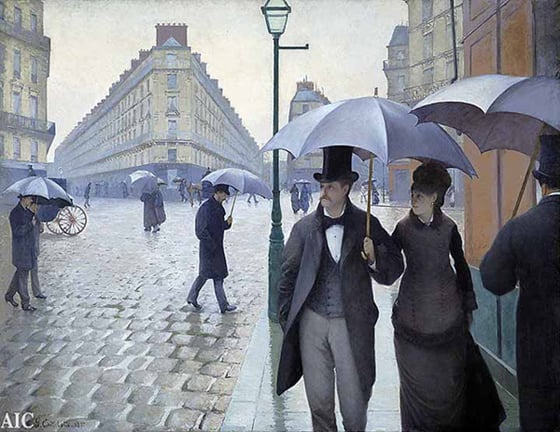
According to Chicagoist, what originally began a routine cleaning of a painting at the Art Institute of Chicago quickly turned into a revealing labor of love. When conservator Faye Wrubel and assistant paintings conservator Kelly Keegan began restoration on Gustave Caillebotte’s beloved 1877 painting Paris Street; Rainy Day, they uncovered striking details hidden under layers of varnish, which Wrubel estimates were applied a half-century before the work was purchased in 1964. Using ultraviolet, X-ray, microscopy, and infrared imaging, they also discovered dark blotches in the sky indicating a layer of paint had been added. Wrubel then undertook the process of carefully removing varnish and added paint from the six-by-nine foot canvas using cotton swabs.
The results reveal more highly-saturated colors—the milky appearance of the canvas that most people are familiar with was in fact not the artist’s intention, but the result of varnish that blanched the surface of the painting. The restoration also revealed sharper edges, more contrast, and a greater overall feeling of visual depth. The female in the painting was originally thought to be wearing a pearl earring, but after removing the varnish, its sparkling appearance shows it is in fact a diamond. The conservators also stripped away about two inches of added paint at the left side of the canvas, revealing the original raw edge, in which the carriage vanishes into thin air.
Walking Alone… or Together?
But perhaps most striking is the observation by 19th-century European painting and sculpture curator Gloria Groom that the two figures, assumed to be walking together, actually now appear to be passing one another. Additionally, the restoration reveals layered brushstrokes, which indicate wet paint modelling on the canvas, rather than the palette. The previously unseen emphasis on capturing motion and subtle variations in light could cause scholars to rethink Caillebotte’s art historical classification.
“What we have been seeing all these years may have been beautiful, we may have all loved it, but it wasn’t right,” Wrubel said of the surprising revelations of the restoration.
Pre-restoration: Gustave Caillebotte, Paris Street; Rainy Day< (1877).
Photo: Wikipedia.